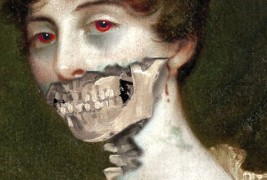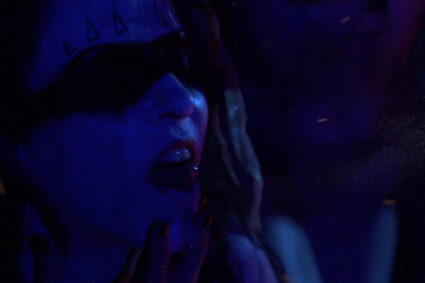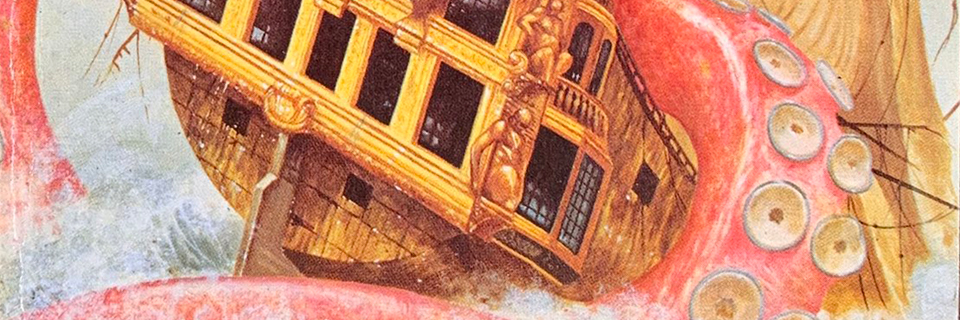
If you’re like the ruck of humanity, when you’ve just fallen in love, you’re kind of like a sugar glider:[1] adorable, hyperactive, chatty, able to defy gravity through sheer exuberance, and annoying as all fuck. When I discovered horror at the age of fourteen, it was puppy wuv at its most pustulently cloying. Not until I met my future wife was such saccharine emotional maggotry on display. One of my favorite ways to inject my infatuation with the genre into every possible human interaction was by reimagining everybody else’s favorite books and movies as horror. My parents were watching Shine? David Helfgott should have communed with the same beings that drove Erich Zann to madness. My sister was reading The Babysitter’s Club? Totally would have been cooler if they babysat the Whateley twins from The Dunwich Horror. Fortunately, I grew beyond such childishness. Rather than just blurt out random speculation, ruining the enjoyment of those around me, I’m writing an entire list article that promises to clog the search engines of anybody looking for Titanic, or Memoirs of a Geisha with an unexpected but disturbingly refreshing infusion of eldritch horror. Let the electronic bottlenecking begin!
*
THE WORK: Titanic.
SCREENPLAY BY: James Cameron.
BUT IT SHOULD HAVE BEEN WRITTEN BY: William Hope Hodgeson. Born in 1877 and dying in the trenches of Ypres in 1918, Hodgeson was a badass action hero-type who in his time was a stuntman (appearing onstage with Harry Houdini), bodybuilder and sailor who even won an award for risking his life to save a shipmate from shark attack. While he sounds like a character from an R.E. Howard story, Hodgeson was a prolific horror writer most famous for his novel The House on the Borderland (an elderly brother and sister live in a family house menaced by humanoid pigs that also serves as a gateway to other universes) and the Carnacki, Ghost-Finder stories, at least one of which also dealt with porcine demons. So why Titanic and not Babe? Because much of Hodgeson’s work drew from his own experience as a sailor, and he produced some of the weirdest maritime horror in print before a certain bedizzened young man from Providence took up the plume.
AND IT WOULD LOOK LIKE:
NIGHT-EXT.-SHIP’S PROW
ROSE and JACK stand on the prow of the ship, arms stretched out as if they are playing airplane. Jack stands slightly behind Rose, and the ship’s ENGINES churn below deck.
JACK
I’m the king of the world!
At once, the ship SHUDDERS and the CREAK of tearing metal can be heard. Rose and Jack are jolted out of their lover’s reverie. As soon as they regain their balance, they look over the edge of the prow into the deep, black water of the Atlantic. The very top of a tower emerges from the water, impaling the hull of the Titanic.
ROSE
What’s that?
JACK
Nothing I ever saw in Triphole Falls!
Lights begin to appear in the water like fireflies. At first there are only a few, but then more and more cluster in the choppy waves. An IRISH SAILOR rushes over with a pistol.
SAILOR
Jesus, Joseph and Mary! What was that?
At once it becomes clear: the lights aren’t fireflies, but bioluminescent, HUMANOID HORRORS with transparent bodies and fangs like viperfish, swiftly clambering up the prow towards the dumbfounded lovers. The sailor takes aim, pulling the trigger as the first wave of the blood-hungry[2] creatures clambers over the guardrail, falling upon PASSENGERS and CREW.
*
THE WORK: Memoirs of a Geisha.
WRITTEN BY: Arthur Golden.
BUT IT SHOULD HAVE BEEN WRITTEN BY: Lafcadio Hearn. I got pretty tired of “J-Horror” back in the early 2000s, and I have Lafcadio Hearn to thank for that.[3] While tweens were daring themselves to watch a series of tamer-than-the-last techno-ghosts more closely resembling Japanese Barbie knock-offs fished from a septic tank, Hearn brought us the terrors of the Snow Woman, the faceless Mujina, and the wraiths of long-dead samurai. Hearn, who lived in the latter half of the nineteenth century, was of Greco-Irish descent but lived in Japan for fourteen years, ultimately marrying a samurai’s daughter and converting to Buddhism. A journalist by trade, Hearn’s interest in the supernatural led him to collect a number of traditional Japanese ghost stories in his anthology Kwaidan, the basis of an awesome 1964 film by Masaki Kobayashi which used long-haired ghosts in a much freakier way than Ringu ever did.[4]
AND IT WOULD LOOK LIKE: “Shamisen lessons started early in the morning, and I had so much trouble at first properly gripping the plectrum. Mother would say to me, ‘Sayuri, how do you ever expect to be anything more than a useless, strumming country girl if you can’t hold your plectrum properly?” Her head would snake off her shoulders on a neck like a great firehose of flesh that would coil around me until she could look me in the eyes. In the great mirrored walls I could see faces of dead girls, generations of apprentice geisha like me who had never learned to hold their plectrums correctly, breaking shamisen strings or hitting notes that displeased Mother.”
*
THE WORK: The Lord of the Rings.
WRITTEN BY: J.R.R. Tolkien.
BUT IT SHOULD HAVE BEEN WRITTEN BY: Clive Barker. I know, I know; I’m toying with a heresy that by rights should earn me a bell, book and candle excommunication from the speculative fiction community. I’m not holding Tolkien responsible for the libraries of shitty fantasy that followed him. I’ll even agree with China Mieville when he says that as fantasy writers, we owe Tolkien for the specificity of his vision, and the sense of a complete, whole, and fully-drawn world.[5] Mieville is an incredible writer, and I think his points are well taken, but he himself once described Tolkien as “the wen on the arse of fantasy literature.”
Maybe it’s that I think Nordic fantasy was better done in the far grimmer and more ambiguous Beowulf, or that years of D&D playing have made me despise elves and orcs and dragons and True Magic That Can Never Die![6] Or maybe, more likely, it’s that even when I was at the height of my love of medieval fantasy, I had to admit that Tolkien was, well, a boring writer. He has his moments of genius (the episode in Moria comes to mind), but I had to force my thirteen year-old self through most of The Fellowship of the Ring and The Two Towers, through all those long and painful descriptions of the Sackville-Bagginses are up to and what type of pipeweed tastes best with Hobbiton crumpets until, in the first few pages of The Return of the King, I gave out. You don’t get characterization or style in Tolkien.[7] So why Barker? Because he’s got a freer, more adult take on fantasy? Because of his willingness to incorporate sexuality into the genre? Because I really want to see a balrog-Cenobite combination? Fuck it, I won’t lie: number three.
AND IT WOULD LOOK LIKE: “The orcs parted ranks as it stepped forward, the flames charring and recharring its flesh, blackening until it peeled and flaked off as soot and then regrew to burn again. Frodo winced as he saw its massive cock, curling in the flames like a writhing python or a thick grapevine in a forest fire. The curling horns were each the height of a man, studded with spikes and nails and rough-wrought steel sheathing and its expressions, during the brief moments when the fire spared its monstrous face, were alternately rage and pain and long-buried lust. With each crack of the flaming lash, the milling orcs moaned, though whether in agony or pleasure, the Fellowship could not tell.”
*
THE WORK: The Bridges of Madison County.
WRITTEN BY: Robert James Waller.
BUT IT SHOULD HAVE BEEN WRITTEN BY: H.P. Lovecraft. He hardly needs an introduction here, so I’ll just say that I’ve never actually read The Bridges of Madison County, although it continually intersects my existence in strange ways. I got a twelve page extract from it in a fantasy and sci-fi writing class I took when I was about fourteen. The teacher threatened that if none of us brought in stories, she would force The Bridges of Madison County on us, and one week we didn’t and she did.[8] At that point, everything I read got compared to Lovecraft, and TBoMC was no exception. When you’re a fourteen year-old into Cthulhu, a love story about people in Iowa isn’t that exciting.
Three years later, we move to Iowa. I’m seventeen, and my mom has just gotten a job teaching history at the University of Northern Iowa, which is the exact same school where Robert James Waller got his B.A. and M.A. and taught business. You probably picture young Hunter, all of seventeen years old, awed to know that he was in such proximity to literary significance, but it didn’t quite happen that way.
And now here I am, writing this article at damn near one in the morning in Cairo, Egypt, and the first book I think of that I wish H.P. Lovecraft had written is The Bridges of Madison County. What darker power conspires so, bending the twin fates of Waller and I into a warped and ominous double helix?[9]
AND IT WOULD LOOK LIKE: “‘We daon’t take metch to strangers in Mad’son County,’ repeated the crone, and Kinkaid studied with a vague horror the way her eyes would not shut, but took on a batrachian appearance. Kinkaid, who came of Waterloo stock, knew that dark legends and forbidden tales had clustered for decades around shadow-haunted Madison County, and had even read certain shuddersome passages in the Necronomicon of Alhazred that hinted that a dark fate would befall any who disturbed the mysterious stone bridges that local rumor said had crossed the rivers of Madison County since before the coppery-skinned Ioway Indians first settled the land.”
*
THE WORK: Green Eggs and Ham.
WRITTEN BY: Dr. Seuss.
BUT IT SHOULD HAVE BEEN WRITTEN BY: Edgar Allan Poe. Everybody loves Dr. Seuss, and anybody with taste loves Poe. So like that bacon-spiked chocolate sundae I couldn’t bring myself to order at Denny’s, this should work perfectly, right?
AND IT WOULD LOOK LIKE:
I will not eat them in a crypt,
I will not eat them in a pit.
I will not eat them whilst interred,
Or with a dark-plumed talking bird.
With a glass of Amon Tillado,
I think they’d still be hard to swallow.
I will not eat them caked in gore,
I will not eat them. Nevermore!
*
In this post-Pride and Prejudice and Zombiesliterary landscape I should probably squeeze this for all the blood in its veins. Mr. Waller, may I propose a collaboration?
[1]Sugar gliders (Petaurus breviceps) are tiny, nocturnal marsupials from Australia and New Guinea, plus a few outlying Indonesian islands. The patagia stretching between their hind and forelegs enable them to glide between the treetops in search of nectar—hence the name.
[2] The last time I mentioned Twilight it caused all kinds of trouble, so I should point out in this modest and unassuming footnote that this is my take on sparkle vampires.
[3] Okay, savage readers, before I go into my full “J-Horror sucks” rant I need to make an embarrassing confession: the American remake of The Ringkept me up for two nights straight. It was the video–the images of the ladder falling in the empty room and the smug-faced woman combing her hair and the horse’s body in the surf. Verbinski brilliantly captured the sensation of a nightmare–surreal, disconcerting, illogical. But yeah–it kept me up. A PG-13 movie did what The Thing, Henry: Portrait of a Serial Killer, and even The Exorcist couldn’t do. I hide my face in shame behind these curtains of lustrous Asian hair.
[4] I should also say that any condemnation on my part of the “J-Horror” phenomenon totally excludes the works of Takashi Miike.
[5] China Mieville’s essay, “Five Reasons Why Tolkien Rocks,” can be found on Omnivoracious at <<http://www.omnivoracious.com/2009/06/there-and-back-again-five-reasons-tolkien-rocks.html>>.
[6] Starting at “elves,” please read this in your breathiest, most longing, drawing-Aragorn-in-study-hall-to-escape-from-the-drear-of-this-mundane-world voice. Will you do that for me? Thanks, savage readers.
[7] It’s only fair to point out that Tolkien was, from everything I’ve read, a really decent and genuinely good guy. When a German publisher in the 1930’s wanted to know if the author of The Hobbit was or was not a Jew, Tolkien lit into him, Hitler, and Nazism in a brilliantly fierce and well-stated letter. It’s also only fair to point out that we owe much of the current regard for Beowulf to Tolkien’s scholarship on the manuscript.
[8] This workshop was run by an author named Brenda Clough, and it was honestly one of the most useful experiences I ever had as a growing writer. I don’t know where Brenda Clough is now, but I owe her for her patience, good-humor and sage advice regarding all my stories about “squishy things.”
[9] I really am in Cairo, by the way. That wasn’t just a touch of Cthulhoid atmosphere.














